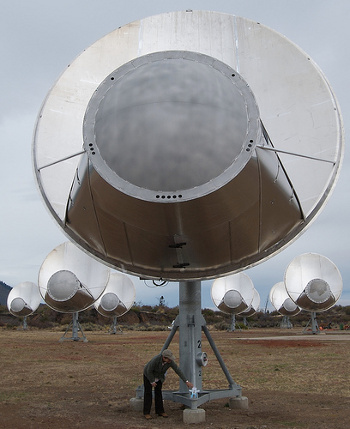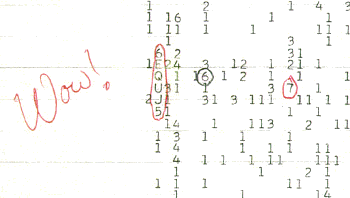Allen Telescope Array
April 26, 2011
There's a joke about
lotteries that might be known to everyone, but I'll retell it, anyways. A religious man prays to God each night that he will win the state lottery. He does this for many years, but he never wins. Finally, the exasperated man asks God in a prayer, "Why won't you let me win the lottery?" God replies, "I want you to win, but you never buy a ticket!" I find a parallel between that joke and the search for extraterrestrial intelligence (
SETI).
You won't discover extraterrestrial radio signals if you don't listen, and you can't listen without the
right equipment. I mentioned one aspect of the SETI search in a
previous article (SETI AI, September 15, 2010). The US government doesn't believe its money should be spent on SETI (perhaps because the
Roswell visitors told them it wasn't worthwhile), so
private foundations have been supporting this effort.
The
SETI Institute (
Mountain View, California), in operation for about twenty five years, has solicited private funding for conduct of a reasonable SETI effort. Its prized instrument has been the
Allen Telescope Array, which I mentioned in a
previous article (Don Backer, August 5, 2010). This
radio telescope is named after
Paul Allen, a founder of
Microsoft, who donated about $30 million of its initial $50 million funding for
research, development and installation of the first 42
antennas of the final 350 antenna array. That stage was completed in October, 2007.

Six meter dish antennas of the Allen Telescope Array (11 October 2007). Note presence of a human for scale.
(Photograph by Colby Gutierrez-Kraybill, via Wikimedia Commons)
The Allen Array antennas look more like
direct broadcast satellite reception antennas than the typical radio telescope
parabolas. They are offset Gregorian, a radio variation of the optical
Gregorian telescope design. The radio waves reflect from the primary onto a secondary reflector and then into a detector. There's a
shield that eliminates
noise from the
Earth below. These antennas operate over a
frequency range of 0.5 to 11.2
GHz.
The Allen Telescope Array is located at the
University of California-Berkeley Hat Creek Radio Observatory, about 300 miles northeast of San Francisco. It would be an impressive instrument if it were completed. Each dish antenna is six
meters in diameter, so the array of 350 antennas would have nearly a 10,000 square meter
aperture (one
hectare, or 2.47
acre). However, one might wonder why we had the first 42 antennas in 2007, and none since.
The
financial meltdown is likely responsible for the lack of donations for the final construction phase. In fact, funding is so meager that the 42 antenna array has just been put into hibernation. Tom Pierson, CEO of the SETI Institute, wrote in his April 22, 2011, letter of explanation that the ATA staff has been significantly reduced, and the hibernation means that the array is unavailable for radio observation. There will be site maintenance, only.[1-3]
Normal operation of the 42 antenna array costs about $1.5 million, annually. Other ATA operations cost an additional $1 million annually. As explained in Pierson's letter, the SETI Institute has been attempting to obtain funding through proposals for using the array for purposes other than SETI. One of these is the tracking of
orbital debris.[4]
SETI researchers are still in business, even with the ATA shutdown, since they've historically been able to piggyback their observations onto other radio telescopes. The problem there is that they don't have the freedom to point the telescope wherever they want. They need to look wherever it's pointed for other work.
All this brings us to the unfortunate question of whether the Allen Telescope Array is really dead. Funding from the
US Air Force to track space debris is unlikely. The Air Force has much more appropriate equipment for this purpose, although it could use the ATA team as a design house for the next generation of instruments. In my experience, $1.5 million in research funding is not that large an amount, as long as the research is something that's valued by the government.

,
August 15, 1977. A still unexplained signal received during a SETI search.
Click for larger view.
(
Ohio State University, via Wikimedia Commons)
References:
- Franck Marchis , "Today the Allen Array Telescope is hibernating," NASA Blogs, April 22, 2011.
- John Matson, "Budget crunch mothballs telescopes built to search for alien signals," Scientific American Blog, Apr 24, 2011.
- Irene Klotz, "Aliens, Call Back Later: SETI Suspended," Discovery, April 25, 2011.
- This Blog, "The Kessler Syndrome," March 3, 2011.
Permanent Link to this article
Linked Keywords: Lottery; SETI; Roswell UFO incident; private foundation; SETI Institute; Mountain View, California; Allen Telescope Array; Don_Backer; radio telescope; Paul Allen; Microsoft; research; development; antenna; Colby Gutierrez-Kraybill; Wikimedia Commons; direct broadcast satellite; DBS; parabola; Gregorian telescope; electromagnetic shielding; shield; electromagnetic interference; noise; Earth; frequency; GHz; University of California-Berkeley; Hat Creek Radio Observatory; meter; aperture; hectare; acre; late-2000s financial crisis; financial meltdown; space debris; orbital debris; US Air Force; Big Ear; Wow signal; Ohio State University.